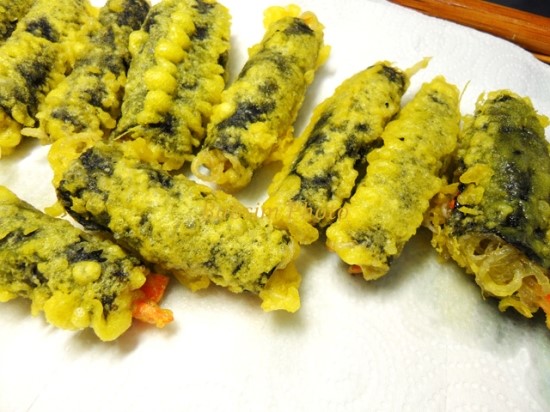
Fried seaweed rolls
It's a fried seaweed roll that goes well with tteokbokki. The noodles are crispy on the outside and chewy on the inside. It's healthy and has pretty color, so it makes you want to eat more and more golden. Even if it's not with tteokbokki, it's a very savory and delicious fried food.
2 serving
Within 30 minutes

밥심은국력
- Ingredients
-
-
Cellophane noodles1handful
-
Carrot1/2ea
-
Flower salt2ts
-
Sugar1ts
-
White pepperlittle
-
grape seed oil2TS
-
dried seaweed for kimbap5piece
-
glutinous rice flour1TS
-
Water2.5TS
-
Cooking oilsuitably
-
Let's do it300ml
-
Water6ea
-
egg2ea
-
Frying flour2cup
-
Frying flourlittle
-
Soy sauce1TS
-
Water1TS
-
Vinegar1TS
-
- Cooking Steps
-
STEP 1/20I used a handful of glass noodles, and if you hold it with your hand, it's a handful.
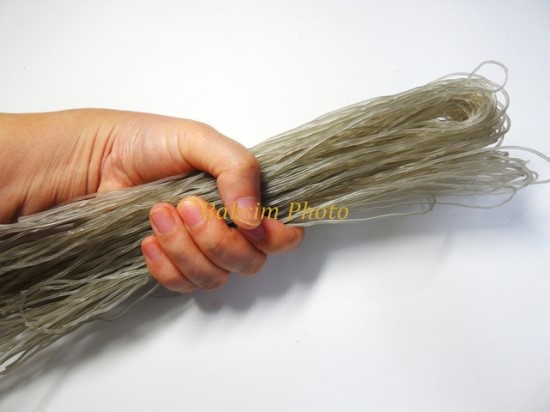 STEP 2/20It's better to soak glass noodles in lukewarm water for about 30 minutes. If you're busy, you can boil it right away in boiling water. When you soak the glass noodles, the glass noodles float up, so it's good to press them with a plate or something. When the water boils, add the soaked glass noodles and boil it for about 3 minutes. If you don't want to boil it, you can boil it for about 6 minutes. I'm going to stir-fry it again anyway, so it doesn't matter if it's a little undercooked. Turn on the tap water, rinse it slightly, and drain the dried glass noodles.
STEP 2/20It's better to soak glass noodles in lukewarm water for about 30 minutes. If you're busy, you can boil it right away in boiling water. When you soak the glass noodles, the glass noodles float up, so it's good to press them with a plate or something. When the water boils, add the soaked glass noodles and boil it for about 3 minutes. If you don't want to boil it, you can boil it for about 6 minutes. I'm going to stir-fry it again anyway, so it doesn't matter if it's a little undercooked. Turn on the tap water, rinse it slightly, and drain the dried glass noodles.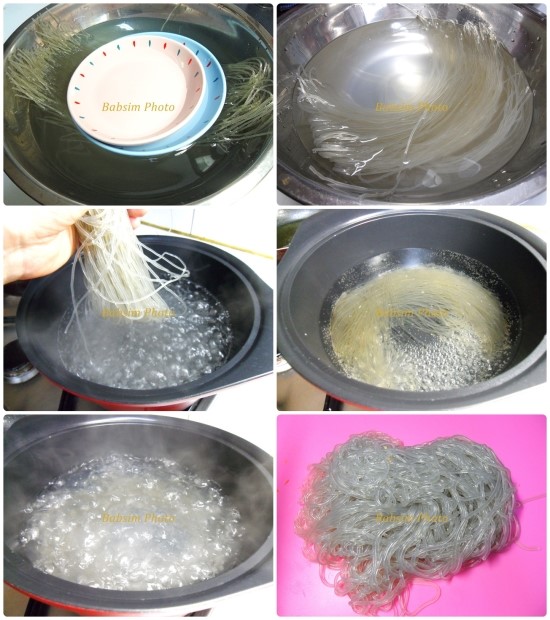 STEP 3/20Shred the carrots. You can chop the onions too.
STEP 3/20Shred the carrots. You can chop the onions too.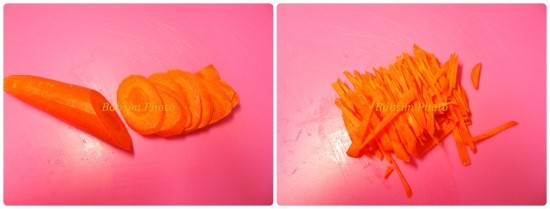 STEP 4/20Since the glass noodles are too long, cut 2-3 equal parts and adjust the length, and mix them with the shredded carrots. Heat the pan and stir-fry about 1 tablespoon of grape seed oil. If you run out of oil while frying, add some more. Add 2 teaspoons of salt, 1 teaspoons of brown sugar, and a little bit of white pepper and stir-fry it. If you put soy sauce instead of salt, it can get greasy, so I recommend salt.
STEP 4/20Since the glass noodles are too long, cut 2-3 equal parts and adjust the length, and mix them with the shredded carrots. Heat the pan and stir-fry about 1 tablespoon of grape seed oil. If you run out of oil while frying, add some more. Add 2 teaspoons of salt, 1 teaspoons of brown sugar, and a little bit of white pepper and stir-fry it. If you put soy sauce instead of salt, it can get greasy, so I recommend salt.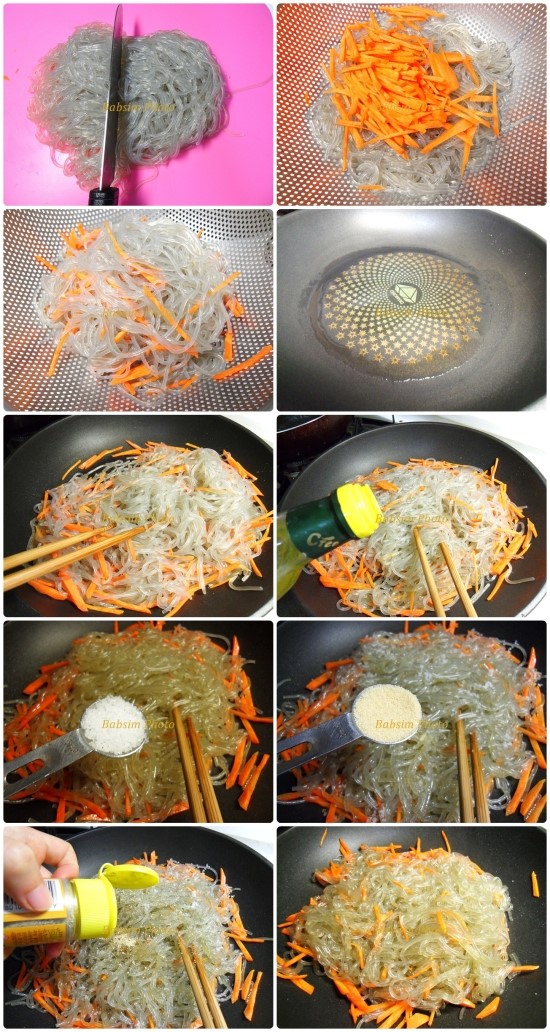 STEP 5/20Cool the fried glass noodles down a little by little. If it's too hot, the steam can get squishy, and it's hard to roll because it's hot.
STEP 5/20Cool the fried glass noodles down a little by little. If it's too hot, the steam can get squishy, and it's hard to roll because it's hot.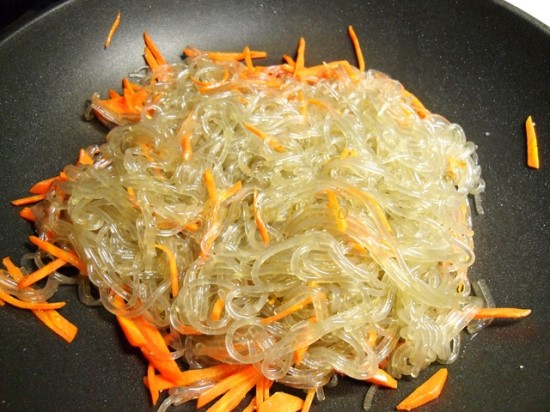 STEP 6/20When you put seaweed on it, you make sticky rice paste and stick it on. Even if you make flour paste, it falls off easily, so I made sticky rice paste and fried it, and it sticks very well. I added 2 tablespoons of water to 1 tablespoon of glutinous rice flour.
STEP 6/20When you put seaweed on it, you make sticky rice paste and stick it on. Even if you make flour paste, it falls off easily, so I made sticky rice paste and fried it, and it sticks very well. I added 2 tablespoons of water to 1 tablespoon of glutinous rice flour.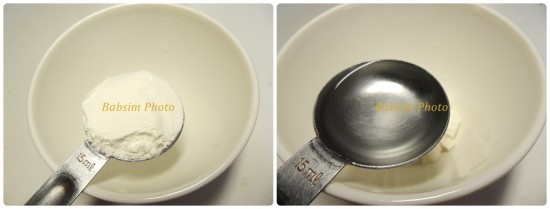 STEP 7/20The concentration is not very thin or thick.
STEP 7/20The concentration is not very thin or thick.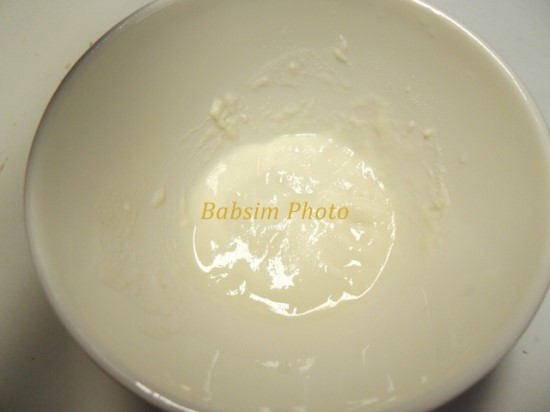 STEP 8/20I like gimbap for seaweed. Cut the seaweed in half and divide it into two again, so that one sheet of seaweed has four equal parts. Fold the seaweed and make a line and cut it with scissors.
STEP 8/20I like gimbap for seaweed. Cut the seaweed in half and divide it into two again, so that one sheet of seaweed has four equal parts. Fold the seaweed and make a line and cut it with scissors.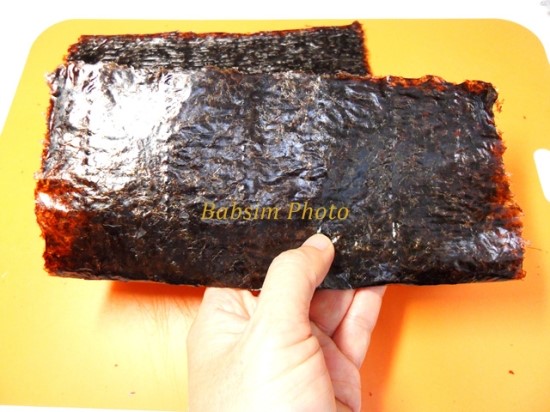 STEP 9/20It's convenient to make small gimbap like this.
STEP 9/20It's convenient to make small gimbap like this. STEP 10/20Add the stir-fried glass noodles.
STEP 10/20Add the stir-fried glass noodles.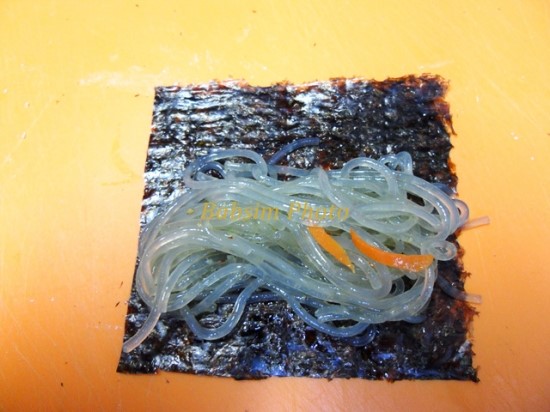 STEP 11/20Spread sticky rice paste on the end of the seaweed.
STEP 11/20Spread sticky rice paste on the end of the seaweed.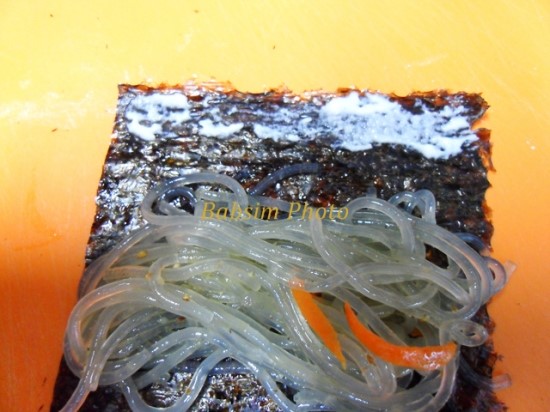 STEP 12/20If you roll it, it's done!
STEP 12/20If you roll it, it's done!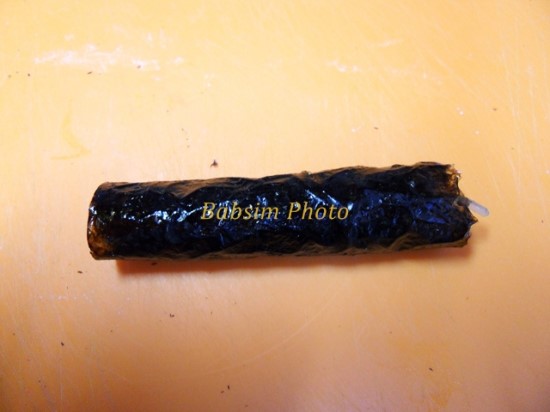 STEP 13/20The color is pretty when you make a dental floss, but in fact, the first thing you do can shorten the cooking time. You can just make it with bottled water without dental floss. Let's smash three of them into 400ml of cold water and strain them through a sieve for 15-20 minutes. It comes out faster if you boil it in warm water, and in this case, you must cool it down.
STEP 13/20The color is pretty when you make a dental floss, but in fact, the first thing you do can shorten the cooking time. You can just make it with bottled water without dental floss. Let's smash three of them into 400ml of cold water and strain them through a sieve for 15-20 minutes. It comes out faster if you boil it in warm water, and in this case, you must cool it down.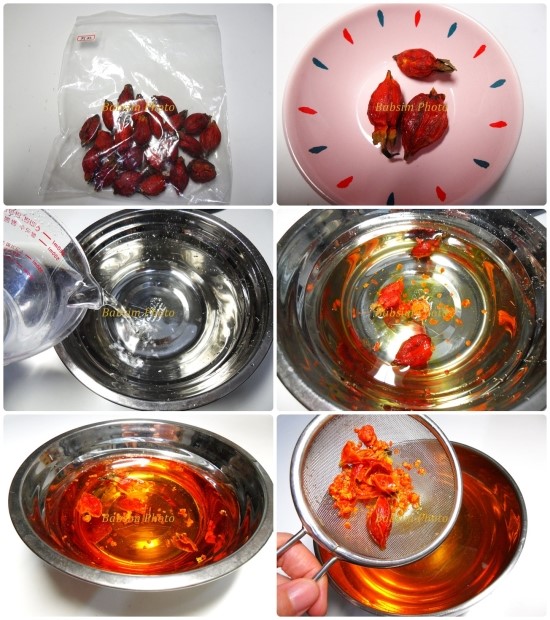 STEP 14/20Make about 400ml of each ice cubes in 300ml of dental water. Frying clothes always swell better when it's cold.
STEP 14/20Make about 400ml of each ice cubes in 300ml of dental water. Frying clothes always swell better when it's cold. STEP 15/20Sift 2 cups of frying powder. That way, it gets a lot of air and the batter swells up. Add two yolks of egg and add dental water. Stir gently with chopsticks. Leave the crumbs to rest. If you stir it too much, it becomes persistent, so it's not crispy. The concentration of the batter is watery enough to flow down. Isn't it pretty to have fried dough with some water? If you don't have it, it doesn't affect the taste. It's just that the color is pretty, which makes you want to eat...
STEP 15/20Sift 2 cups of frying powder. That way, it gets a lot of air and the batter swells up. Add two yolks of egg and add dental water. Stir gently with chopsticks. Leave the crumbs to rest. If you stir it too much, it becomes persistent, so it's not crispy. The concentration of the batter is watery enough to flow down. Isn't it pretty to have fried dough with some water? If you don't have it, it doesn't affect the taste. It's just that the color is pretty, which makes you want to eat...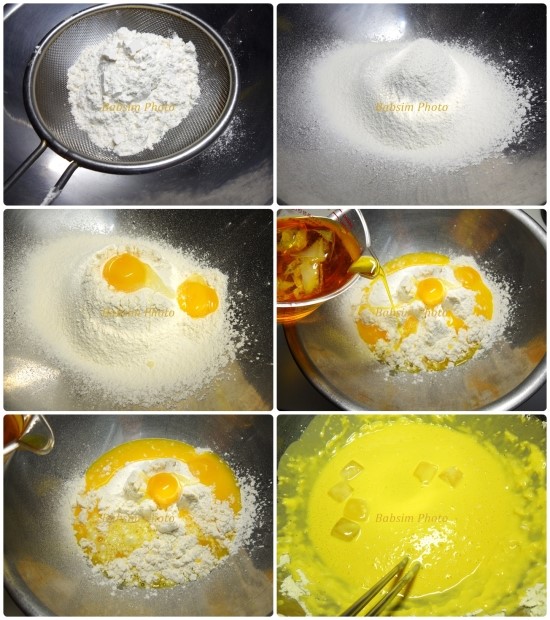 STEP 16/20Put some frying powder on the seaweed roll
STEP 16/20Put some frying powder on the seaweed roll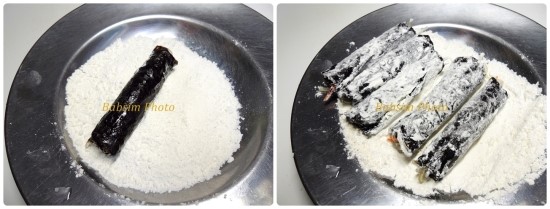 STEP 17/20Put it in the batter
STEP 17/20Put it in the batter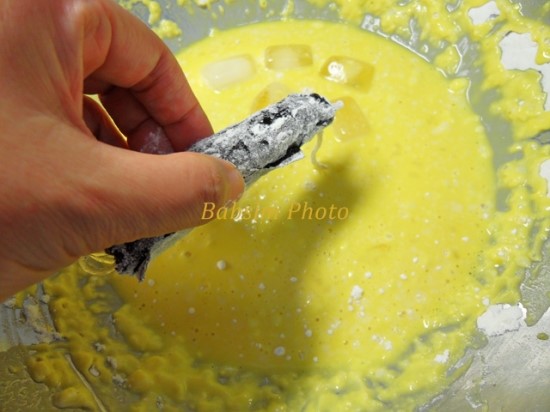 STEP 18/20You can coat it evenly.
STEP 18/20You can coat it evenly.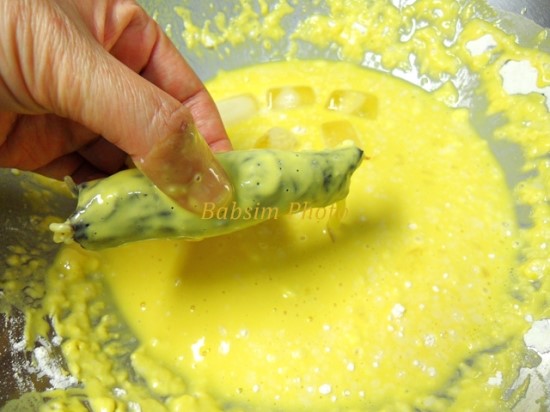 STEP 19/20The temperature of the oil is the right hot tool when it comes to mind after dropping the batter. Another way is to put frying wooden chopsticks on the floor, and if there are seven to eight bubbles, it's the right temperature. To prevent the oil from splashing, don't put it from the center, but put it in the edge of the pan by rolling the seaweed roll.
STEP 19/20The temperature of the oil is the right hot tool when it comes to mind after dropping the batter. Another way is to put frying wooden chopsticks on the floor, and if there are seven to eight bubbles, it's the right temperature. To prevent the oil from splashing, don't put it from the center, but put it in the edge of the pan by rolling the seaweed roll.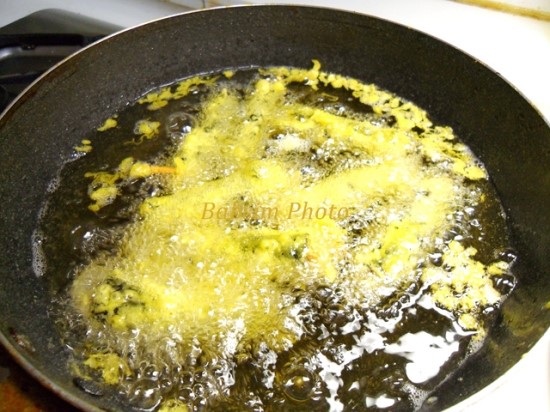 STEP 20/20Isn't the color pretty because it's a seaweed roll with dental flakes?
STEP 20/20Isn't the color pretty because it's a seaweed roll with dental flakes?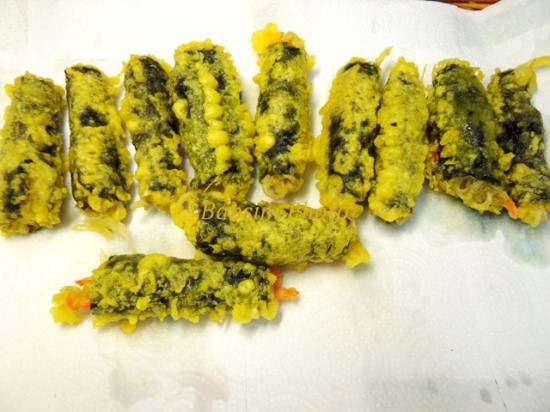
- Cooking review
-
5.00score
-
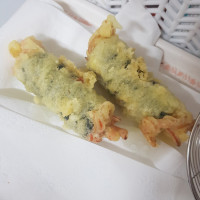 559*****scoreIt was better than buying it!2020-05-24 11:41
559*****scoreIt was better than buying it!2020-05-24 11:41
-
- Japchae Recommended recipe
-
-
1
 Meatless japchae (paprika japchae with only vegetables)4.88(16)
Meatless japchae (paprika japchae with only vegetables)4.88(16) -
2
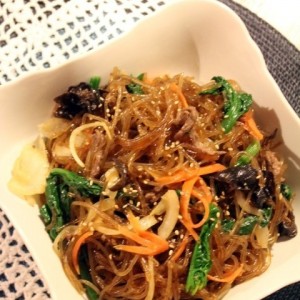 If you don't watch it, you'll regret it - super fast japchae gol4.71(28)
If you don't watch it, you'll regret it - super fast japchae gol4.71(28) -
3
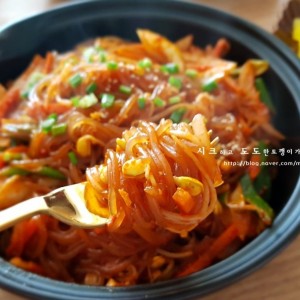 Spicy bean sprout japchae4.79(127)
Spicy bean sprout japchae4.79(127) -
4
 A more delicious japchae with a golden recipe4.87(15)
A more delicious japchae with a golden recipe4.87(15)
-
- Kimchi Recommended recipe
-
-
1
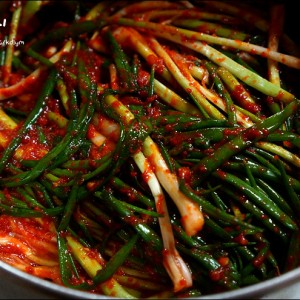 Making green onion kimchi4.82(106)
Making green onion kimchi4.82(106) -
2
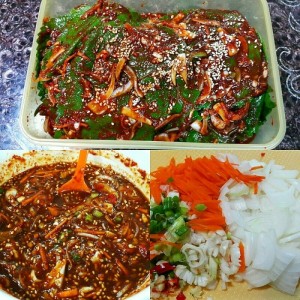 Rice thief. It's not hard to make perilla leaf kimchi^^4.97(743)
Rice thief. It's not hard to make perilla leaf kimchi^^4.97(743) -
3
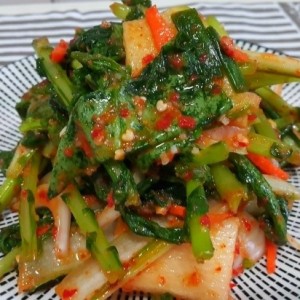 How to make young radish kimchi deliciously (Jeollado Kimchi)4.96(47)
How to make young radish kimchi deliciously (Jeollado Kimchi)4.96(47) -
4
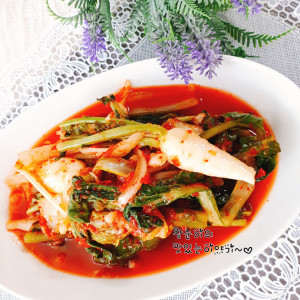 Short soup with young radish kimchi4.97(39)
Short soup with young radish kimchi4.97(39)
-